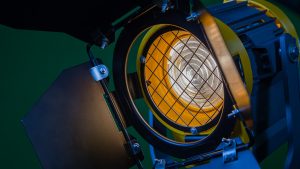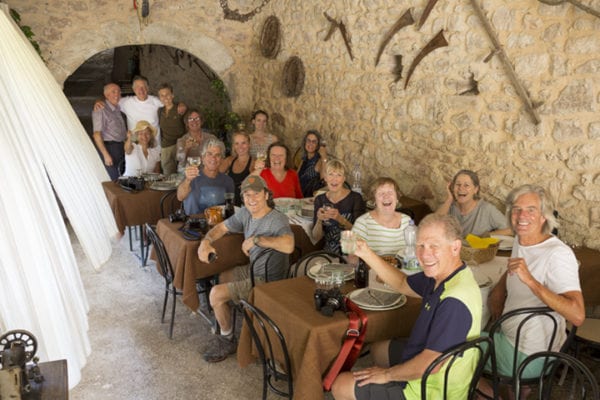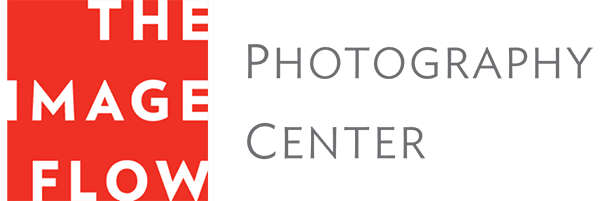

Jeff Zaruba and I arrived in Umbria a few days before the workshop began to scout locations with our Italian assistant Lorenzo. Those first couple of days were busy, but they were nothing compared to the non-stop action once the workshop began.
We had 10 students in the group and one of the students brought along his wife. On our first day of shooting, we went to a bed and breakfast we’d scouted a year ago. The location is extremely picturesque and Eleanora was all ready for us: The kitchen was set up for us to shoot while she prepared lunch, and she’d planned a wonderful menu.
Lunch was served in a tunnel that’s between her place and the little town. When we’d scouted there last year, the tunnel was full of junk—old bicycles, tools, and other lousy stuff. They’d gotten all of that cleaned up, decorated it with artifacts and antiques, and set tables down the length of the tunnel. Along one wall there were archways that overlook the valley. Eleanora had made curtains that kind of danced in the breeze while we were eating. That was one of the most special days for me, and it was only the beginning.
We never left La Romita, the 16th-century monastery-turned-art-school where we were based, super early, usually around 10AM, but some evenings we didn’t return until 11PM—or later. Jeff and I worked hard on the schedule to make sure we didn’t spend two consecutive days driving too far, and after three days, scheduled either an afternoon or a morning with nothing planned. We didn’t want people to get too burned out and also to give them some freedom to explore or reshoot something they were interested in.
Because the workshop focused on locations that support the Slow Food Movement in Umbria, many of our shooting excursions also involved eating. One day we went fishing. Before we went out on the lake, they cooked us lunch from fish they’d caught, prepared in a traditional way, and served al fresco under a couple of willow trees.
On another day, we shot in a restaurant kitchen. Two students at a time could go in to shoot while the chef was preparing the meal. Then they brought out finished plates of food for us to shoot outdoors on their beautiful grounds while they cooked us dinner. We paid them for this of course, like all of the people we visited, but when you factor in what we got out of it, it was an absolute bargain. And yes, wine was included!
Of all the people, places, and things we photographed, one of the most challenging and also most successful locations in terms of the quality of the resulting photographs was the day we shot at the pea farm. The owner is focused on growing a type of pea that’s nearly extinct. He’s got about four acres of land where he’s growing these peas. The plants are really low to the ground, and they have an orchid-like flower when they’re ready to be harvested. We shot workers in the field, and then we went up to his farmhouse—he’s also got a vineyard and olive trees—and he demonstrated the process of thrashing and sifting the peas out of the pods. And then, of course, they served us a light lunch. Every dish was made from those peas.
It was one of the most challenging scenarios because of the midday sun, the motion of the thrashing, and finished food. We gave a lot of instruction to the students on how to get a dynamic photograph during the thrashing process in terms of point of view and using slow shutter speeds. You really had to work to get a decent picture, but we got a lot of decent pictures out of it.
I shot a little bit during the nine days, but it was minimal. I hear a lot about other workshops in which the instructors spend too much time shooting; I want to spend my time primarily working with the students. Of course, sometimes the photograph that presents itself is too good to pass up, and I did shoot a few from time to time, but it was relatively rare.
One of our last meals was with a gentleman farmer, Alessandro, a lawyer who works in Milan and lives in Umbria. He’s got a fairly large place, an old farmhouse he bought 30 years ago. Over the years he’s turned it into a sanctuary with manicured gardens and a swimming pool, but it’s also a working farm.
His goal is to do the type of farming that was done 100 years ago in Italy. He’s got an olive grove manicured by donkeys (the only animals that will eat the grass without disturbing the trees) and four Duroc pigs—they’re really muscular, kind of like a bulldog. Each of the pigs gets two acres of land to graze on. Alessandro barely has to feed them, just some occasional table scraps, so they’re basically free range. In a year he hopes to have 20, and they make some of the best prosciutto you can imagine eating.
We couldn’t have put this workshop together without the help of Sergio Montebello, son of Alberto Montebello, the former president of Slow Food Umbria. Not only did Sergio do an excellent job getting us connected with the most important contributors to Slow Food in Umbria, he’s also a butcher known for his fantastic sausage.
After we photographed Alessandro’s farm, he generously hosted our sausage making demonstration with Sergio, and then hosted us for dinner. There was a barbeque set up on the terrace all ready to feed 14 strangers. Not only that, but Alessandro’s father keeps a sculpture studio on the grounds. All of his sculptures are made from clay found on the property. He opened up his studio for us to shoot and signed a copy of his exhibition catalog for each of us. This kind of generosity was basically the norm with everyone we met.
What I enjoyed the most was seeing how excited everybody was with the way things worked. The trip came off without a hitch, and we had some really spectacular locations. We had a couple of people in the group who were relatively new to photography, but they caught on remarkably quick.
The overall impression of the week was extraordinarily high, despite the fact that it was 107° one day. It was too hot, but everyone was focused on the photography. A lot of people could see that they were making progress and they were trying to do better and better.
The days were long. On the day we went to Assisi, after battling the tourists for a few hours, we went on to the nearby village of Spello. We had dinner on a terrace that overlooked the valley. It had to have been close to 10:30 when we left and we still had an hour and a half drive home. When we got back to La Romita, a lot of people went to bed, but a few of us stayed up, sitting outside, drinking wine, and talking. It was wonderful to have that comfortable, home-like base to come back to each evening. I admit I was a little nervous at the start—it is, after all, a monastery and pretty sparse accommodations—but it furthered the feeling of community, the feeling that in just a few days, we’d become like a family.
We’re already planning to return to Umbria, next year at the end of September or early October. We’ll go a bit later to catch more of the harvest activity, maybe even in the vineyards. We may visit many of the same locations, but with the different activity and early fall sunlight, it will be a completely different experience. We’re also planning a workshop in Florence prior to Umbria, which will focus on small tradesmen and artisans. Make sure you’re signed up for our newsletter (in the footer below) to get first access to both those workshops.
Arrivederci!
— Stuart

